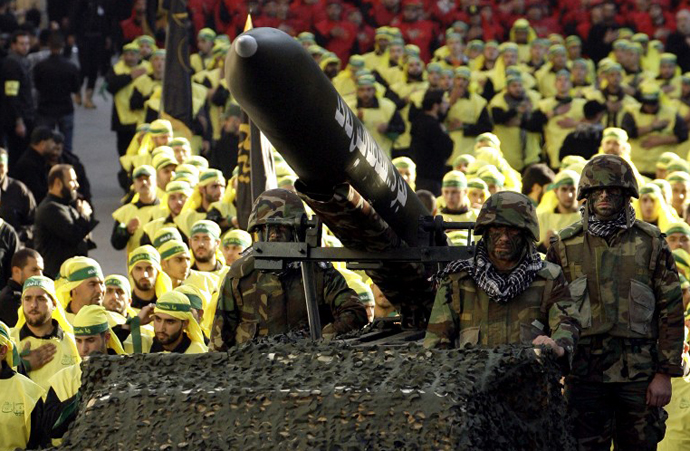While Israeli intelligence officials believe the Shiite organization is experiencing the most difficult phase in its history after losing some 1,300 fighters in the Syrian battlefields, its leader Nasrallah is only intensifying preparations for the next conflict with Israel. World powers’ nuclear agreement with Iran could strengthen Hezbollah even more.
On Friday, May 15, a convoy of about 12 bright black vehicles left Beirut along with a number of off-road vehicles packed with uniformed fighters. The convoy turned east and drove quickly towards the Syrian border. They didn’t raise too much attention among the passersby: Similar convoys of Hezbollah members have been entering the bleeding battlefields in Syria for the past two years. Only some of them will get to see Lebanon again.
But this time, it was different. The black vehicles were carrying Lebanese and Western journalists – including correspondents for Reuters, The Associated Press, The New York Times, The Wall Street Journal, German media, etc. – not the population segment which Hezbollah is usually fond of.
They were driven to the border of the fighting zone in the Qalamun Mountains in Syria in order to view the lands Hezbollah recently conquered from the “takfiris” (the infidels, a combination of Arabic and English, as Hezbollah refers to the rebels in Syria). The goal was clear: To show the world how Hezbollah is fighting the Islamic Stateand other members of the “radical and dark Islam,” according to one of the escorts on behalf of Hezbollah, which the West is so afraid of.
One of the participants of this unusual tour told Yedioth Ahronoth last week in a conversation from Beirut that the escorts had gone out of their way to make sure that the journalists were satisfied and received everything they wanted, so that they would produce a favorable article. He said there had been some preconditions – no “political talk” and handing over all cell phones at the beginning of the tour – but the refreshments were not bad and there was a pleasant atmosphere. Relative to Hezbollah, of course.
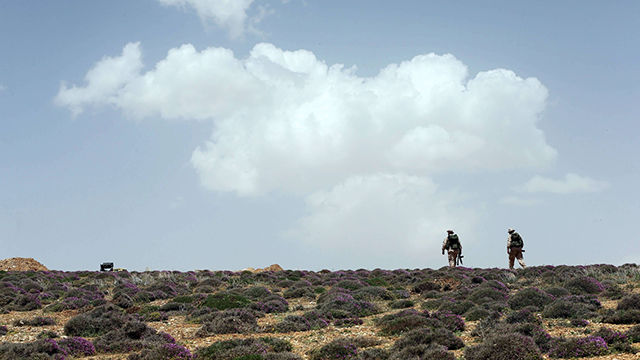
Journalists’ tour of fighting zone in Qalamun Mountains. The goal was clear: To show the world how Hezbollah is fighting the ‘radical and dark Islam’ (Photo: AFP)
The tour began in Baalbek, the organization’s most important stronghold in Lebanon. From there, the convoy drove up to the mountains bordering Syria. The Hezbollah fighters proudly pointed at charred remains of vehicles and weapons and said they used to belong to members of Jabhat al-Nusra, the jihadist Sunni militia fighting Syrian President Bashar Assad.
The journalists were impressed. “Entire areas of the border, from Brital (a town in eastern Lebanon) and southward, are protected and controlled by Hezbollah. There is no Lebanese army there, and there is no Syrian army. The Hezbollah organization is the one protecting Lebanon from an ISIS invasion: Posts, weapon convoys and dozens of overly armed fighters, who are willing to stop any attack with their bodies,” one of the journalists reported.
The tour continued, stopping at Shiite villages in the area. There, the journalists met civilians, who naturally thanked Hezbollah for helping them keep their heads attached to their necks – although ISIS and its friends are right here, around the corner.
“I would be happy if the Lebanese army could protect us,” one of the villagers told the journalists. “But Israel and the United States are preventing the transfer of advanced arms to the Lebanese army for fear that it would attack Israel later on, so it’s failing to become a significant military power. Therefore, there is no one who can protect us. Apart from Hezbollah.”
And that’s the exact message that Hezbollah of the summer of 2015 is trying to convey: Hezbollah is the real defender of Lebanon and the last force preventing the Land of Cedars from falling into the hands of radical Islam. Therefore, despite its conflict with Israel, when it comes to fighting ISIS and its partners – Hezbollah is actually helping the West.
But as usual, where Hezbollah Secretary-General Hassan Nasrallah is concerned, it’s only part of the picture. The journalists were not shown the many graves, scattered across southern Lebanon, of Hezbollah fighters killed in the battles in Syria. There was also no mention of the fact that the unrest against the organization is increasing in Lebanon, and in general, that Hezbollah is in one of the most difficult moments in its history.
They were also not told that in the meantime, Hezbollah is also speeding up its preparations for the third Lebanon war, and that this time it has no intention of settling for firing rockets and missiles at Israel.
There are those in the Israeli intelligence community who are now referring to the organization as “Hezbollah 3.0” or “Third Generation Hezbollah”: The first generation was the founding generation during Israel’s presence in southern Lebanon; the second is Hezbollah of the Second Lebanon War; and now it’s a completely new Hezbollah. On the one hand it is sinking on the Syrian mud, and on the other hand it is gaining vast combat experience and new weapons – and is planning to use both in due course. The only question is when.
Through research reports and conversations with intelligence sources, Yedioth Ahronoth outlines an internal profile of the military force, which was and will likely remain Israel’s No. 1 enemy. Yes, even when ISIS sits on the fences.
Killing the ‘takfiris’
Up to a year ago, Hezbollah was still doing everything in its power to cover up its involvement in the battles splitting Syria. The organization, which gave each of its fighters who died in the battle against Israel a huge pathos-filled funeral, actually concealed the funerals of its fighters who were killed in masses in Syria. They were buried quietly, in the darkness, in the presence of the families only. Nasrallah anyway found it difficult to deal with the criticism leveled at him: Instead of fighting Israel – the reason for Hezbollah’s existence – the organization is now busy killing other Muslims.
No one ever dreamed that Western journalists would be invited to tour the battle zone either. Wafik Safa – the man notoriously remembered in Israel from the return of the bodies of kidnapped IDF soldiers Ehud Goldwasser and Eldad Regev – conveyed filtered messages, most of which were only directed at the Lebanese public. These messages were relayed through media outlets under full Hezbollah control: The organization’s television station, Al-Manar; a series of websites led by Al-Muqawama (“the resistance”) and the blog “Sayyed Hassan Nasrallah”; and (quite a large) number of Lebanese journalists perceived as being loyal to the organization.
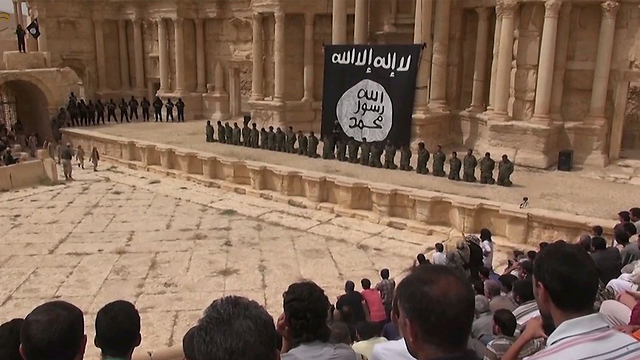
ISIS execution in Syria. The ‘new Satan’ in the eyes of the West
Hezbollah’s contact in the press, Ibrahim Mousawi, turned down any request for a response or for joining the organization members on any type of activity. The few attempts made by media outlets to document the night funerals were met with an even more aggressive opposition. Even interviews with Hezbollah’s representatives in the Lebanese parliament (Majles al-Nouwab al-Lubnani) were blocked.
But then Nasrallah realized that the depth of his organization’s involvement in Syria can no longer be concealed – and that he should even use it for his own benefit. It happened when the beheading videos turned ISIS into the new Satan in the eyes of the West. And who is on the ground to fight it? That’s right, Hezbollah.
Nasrallah changed his approach by 180 degrees: The new Hezbollah is no longer ashamed of the fact that its soldiers are getting killed in Syria; on the contrary, it is proud of it. They are dying in order to eradicate an enemy which is endangering all of humanity. Almost overnight, the funerals of the fighters killed in Syria turned into huge ceremonies and well-covered military shows of force.
That was also the start of an image change. Ibrahim Mousawi was replaced a year ago by Mohammed Afif, who previously served as the Al-Manar station manager. Afif has been tasked with rebranding the radical organization. It’s not easy, but the fact that there is someone more radical around, with a special fondness for horrific executions, helps him greatly.
“It’s very important to Afif,” says a journalist representing a major Western European media outlet in Beirut, “to stress that ISIS and Jabhat al-Nusra are enemies shared by all of us – Hezbollah, the Lebanese people, the Syrian people and the West. They are saying: You, the West, see all of us as one bloc of radical Arabs, but it’s not true. There is an enlightened and progressive Islam, which is the Shiite Hezbollah’s Islam, and there is a dark and horrible Islam, the radical Sunnis. They are the ones we must all fight.”
But Israeli officials have no doubt about the real intentions of the new “defenders of the West” from southern Lebanon. “Hezbollah is Israel’s most challenging enemy and our main reference point for some 30 years now,” says Colonel (res.) Ronen Cohen, the former director of the Terrorism Desk at the IDF Military Intelligence Directorate and deputy head of Military Intelligence’s Research Division. Today Cohen is one of the owners of Inspiration, a company specializing in managing security projects and providing intelligence collection and information processing and analysis services in Middle Eastern and Persian Gulf countries.
“Hamas is an important challenge as well, of course, but it was always the ‘small brother’ standing in Hezbollah’s big shadow. Since the Taif Agreement (1989), which left Hezbollah as the only armed militia in Lebanon, we realized it is the main strategic threat as far as we are concerned. The operation of command and control systems, the Iranian-sponsored training, the weapons, and especially the rocket arsenal and warfare perception have been duplicated in Gaza time and again.”
The Israeli intelligence community understands very well that Hezbollah’s situation has changed extremely since the end of the Second Lebanon War. Last June, Nasrallah’s rhetoric against Israel became particularly aggressive. During one of the weeks that month he delivered as many as three speeches, which included direct threats against Israel.
At the moment, intelligence experts believe, Hezbollah is not planning to attack Israel in the near future, mainly because it is investing its power in the fighting in Syria. And what will happen there? Some estimate that eventually – despite the huge support Assad is receiving from Iran and Hezbollah, the Syrian president will slowly wear out, and collapse. Only then will Nasrallah return to Israel’s northern border, redeploy and seek to restore his initial position – Lebanon’s “defender” against Israel – as soon as possible.
Other estimates raise the possibility that Nasrallah won’t even wait for the results of the war in Syria and will launch a move against Israel even before Assad’s collapse.
In any event, “Hezbollah is in the most difficult situation in its history,” Brigadier-General (res.) Dr. Shimon Shapira, a former Military Intelligence official and Prime Minister Benjamin Netanyahu’s military secretary during his first term, estimated recently. We spoke in early June, before he was appointed as the foreign minister’s chief of staff.
Shapira mentioned one of Nasrallah’s recent speeches, in which the secretary-general said that “our existence is being threatened”. “Hezbollah is getting dragged into an increasingly deeper involvement in Syria at Iranian orders,” Shapira says.
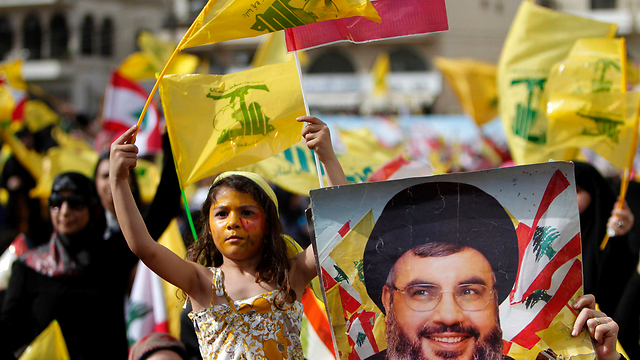
Hezbollah supporters in Lebanon. Harsh criticism from outside the organization and the Shiite faction (Photo: Reuters)
But this involvement comes with a bleeding price tag. According to an updated Military intelligence estimate, the number of Hezbollah members sent to fight in Syria is higher than 6,000 and may have even reached 8,000. This is a huge number for the organization, and it is essentially the majority of its finest combat power. The Israeli intelligence’s updated estimations are that about 1,300 of the organization’s soldiers have been killed so far in the battles in Syria.
“This is an intolerable price as far as Hezbollah is concerned,” says Shapira. “It’s more than they lost in all the battles and wars with Israel put together.”
This price is beginning to evoke criticism within and around the organization. “Hezbollah is making a huge effort to silence authentic voices coming out of the Shiite faction against the involvement in Syria,” says Shapira.
The loudest speaker was Subhi al-Tufayli, the organization’s first secretary-general. Al-Tufayli announced that as far as he is concerned and according to his religious perception, whoever dies in battles in Syria is not a “shahid” (martyr), and will therefore not reach heaven. It’s difficult to underrate the power of this statement, which rocked the organization.
“After he said what he did, al-Tufayli received a scathing visit at his home in Brital, and has since moved to the ‘Keeping the Silence’ organization,” Shapira reports.
Al-Tufayli is not alone. A series of Shiite intellectuals, including women, are harshly attacking Hezbollah over its aid to Assad.
Hezbollah is also starting to feel the discomfort among the fighters and their family members. Only recently, Nasrallah issued an unusual order: In families of a fighter who died in Syria, there will be no additional recruitment to Hezbollah’s combat units.
“Hezbollah used to brag about parents who had one child killed in battles with Israel and immediately announced that they were putting their other children at the organization’s disposal,” says Shapira. “Today you don’t hear such things anymore. Why? Many in Hezbollah understand that while the enemy is the ones Hezbollah refers to as ‘takfiris,’ at the end of the day they are Muslims. It’s a war within Islam, between Sunnis and Shiites. Not a war against Israel.”
Nasrallah’s problems
But the main criticism against Hezbollah is leveled at it from outside the organization and the Shiite faction. Why, ask the Sunnis – the Druze and Christians in Lebanon, is Hezbollah claiming that it remains an armed militia in order to fight Israel, but is actually helping Assad massacre the citizens of Syria?
Hezbollah’s support for Assad has even led to terror attacks against Hezbollah carried out by Syrian Sunni organizations, some of which belong to the global jihad.
Jabhat al-Nusra is not sparing any efforts either to reiterate that its members will never forgive and never forget. The organization’s commander in the Qalamoun Mountains, for example, wrote in a few tweets on his Twitter account on July 7: “A message to Hezbollah: Your support for Nusayri (a derogatory nickname for Assad’s regime) demonstrates your hatred towards the Sunnis. You jailed their women and betrayed (the refugees) who sought your help, begging to be given a shelter in your country. Don’t you dare think that you will escape our anger even many years later. We promise you the same destiny as God promised the people of Israel, when they turned to idolatry. We won’t lay down our sword until the Sharia law (the Islamic religious law) dominates the country and until we avenge our dignity.” Hezbollah, it seems, has created another front for itself.
At first Nasrallah tried to deal with the problem by founding a satellite organization called Hezbollah Syria, thereby perhaps slightly diminishing the direct link between Hezbollah of southern Lebanon and the Hezbollah which kills Muslims in Syria. Hezbollah’s graphic designers even designed a flag for the organization with the caption “We yearn for you, Zaynab” (Zaynab is the daughter of Ali, the first Shia imam. There is a very sacred Shiite compound named after her in the outskirts of Damascus. Hezbollah claimed at first that it only entered Syria in order to defend this compound).
The idea was that the Hezbollah Syria organization would settle down near the Golan Heights, and later open another front against Israel. Nasrallah put Jihad Mughniyeh, the son of Hezbollah commander Imad Mughniyeh who was killed in 2008 in an assassination attributed to Israel and the United States, in charge of the unit. Nasrallah sought to create a symbol, a sort of future generation – the son’s revenge for the death of his martyr father.
The son did follow in his father’s footsteps, but not the way Nasrallah had planned: In January 2015, an assassination – which was also attributed to Israel – ended Jihad Mughniyeh’s life(and the life of another high-ranking Iranian general). Instead of Mughniyeh, Nasrallah appointed Samir Kuntar, the murderer of the Haran family from Nahariya, to command the organization. Dr. Shapira sees it as a Hezbollah attempt to also recruit the Syrian Golan’s Druze, who are paying a bloody price for the Sunni rebels’ fanaticism.
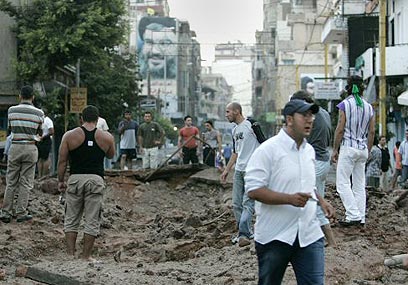
IDF strike in Beirut in the Second Lebanon War. ‘Nasrallah and his men are operating on the ground as if the war with Israel is about to break out tomorrow morning’ (Photo: Reuters)
Meanwhile, Hezbollah hasn’t had too many successes on the Israeli front either. Since Imad Mughniyeh’s death, the organization has been hit with a series of blows, most of which it attributed to Israel: Assassinations of a few other activists, led by Hassan Lakkis, the head of Hezbollah’s arms development wing; mysterious explosions in the organization’s armament sites; and repeated bombings of weapon convoys from Syria to Lebanon.
According to Hezbollah’s perception, the activities it attributes to Israel against it means that the Israeli intelligence has deeply penetrated its ranks. This is quite a blow for Nasrallah: If these actions, or part of them, were indeed carried out by Israel – how is it succeeding, again and again, in infiltrating a closed, departmentalized and idealistic organization like Hezbollah?
Recently, Hezbollah claims, it managed to expose a person spying for Israel within the organization. According to reports, Mohammed Shurba from the southern Lebanon village of Mahrouna began working for the Mossad in 2007. Hezbollah’s suspicions were raised after five failed attempts to avenge Mughniyeh’s assassination. Shurba’s position was in the unit responsible for Nasrallah’s security, and he later assumed senior roles in Unit 910, which is responsible for Hezbollah’s operations abroad.
Shurba was recruited by the Mossad, according to reports in Lebanon, during one of his trips to Asian countries as part of his job. According to Hezbollah, they had their suspicions against Shurba, and then a source in the organization told him about a planned “operation” against one of Israel’s embassies, which would be executed within 48 hours from a certain operations apartments. Hezbollah members were apparently watching the apartment from outside, and shortly after they saw local police forces raiding the place (and finding nothing, of course), Shurba was arrested.
By the way, Shurba was arrested about two months before the assassination of Jihad Mughniyeh. If the claims regarding Israel’s involvement in the assassination are true, then even after Shurba, the alleged “Israeli spy,” Nasrallah’s organization remains transparent to Israel.
Nasrallah’s problems don’t end here. Serious criminal proceedings are underway in The Hague against members of the organization for the murder of former Lebanese Prime Minister Rafik Hariri in 2005. In addition, a series of financial corruption affairs – some of which are unknown outside the organization – have caused Iran to cut its financial support for the organization and have created difficulties in its cash flow. And with ideology alone, as we know, one can’t buy rockets.
‘A sensitive matter’
Despite Hezbollah’s tough situation – and perhaps because of it – Nasrallah and his men are constantly busy preparing for the next war in Israel. “They are operating on the ground as if the war is about to break out tomorrow morning,” says a senior military source.
Two years after the Second Lebanon War, Nasrallah announced that his forces were ready with more missiles and more people than they were on the eve of the war, in July 2006. Since then, the organization is only growing stronger.
“They gave the keys to the new apartments in the Dahiya area, instead of the ones that were destroyed, to the tenants three-four months after the war, and only after they finished rebuilding all the military facilities destroyed by the Air Force,” says Colonel (res.) Ronen Cohen. Their list of priorities is clear.”
According to estimates, Hezbollah currently has 80,000 to 100,000 missiles and rockets, which are all directed at Israel. In addition, the organization has greatly improved its unmanned aerial vehicles and has built a unit of “suicide” aircraft, which can reach many areas in Israel and explode on selected targets.
“Hezbollah has an interest to divert the attention from what is happening in Syria,” the journalist from Beirut says,” and to repeat all the time: Don’t think that the fighting in Syria is discouraging us from fighting Israel.”
A Lebanese journalist was recently permitted to enter some of the “modern bunkers” built by the organization. He was led there with his eyes covered, and the cover was only removed once the door behind him was closed. His report spoke about new electricity and ventilation systems, modern encoded communication with the Hezbollah headquarters in the Dahiya, and more. All this, he was explicitly told, is part of the preparations ahead of the next war with Israel.
Israel is not blind to these Hezbollah efforts and has significantly increased its routine intelligence monitoring of every movement made by the organization’s forces in Lebanon. The allegedIsraeli drone which crashed into the sea in Lebanon earlier this month could be an example of these efforts.
The IDF is also very busy with the tunnel issue in the north. The IDF Spokesperson’s Unit confirmed only recently that following complaints of digging sounds heard at night, the army is holding a comprehensive investigation into suspicions that Hezbollah is digging tunnels under the Israeli border. It’s unclear how reliable this inquiry is, as there is still no reliable technology allowing the detection of tunnels – apart from some parts of the southern border, where the defense establishment is building a seismic fence against tunnels.
Sources in the IDF say the army has failed to find any evidence of tunnels being excavated by Hezbollah. A military source told us, however, that data received from the company which carried out the investigation did not rule out the existence of tunnels.
The question is: If Hezbollah does have tunnels, what will it do with them? According to Ronen Cohen, “Since the great admiration which captured us when we saw the Americans’ performance against Iraq in 1991, we raised the banner of ‘counter warfare’: Massively using the Air Force combined with special units and very little ground invasions, if any.
“A new security perception was built around the ‘counter warfare,’ which relied on deterring the enemy and was backed by statements from senior officials in the military and political echelons that Israel could not reach a clear victory and that we should therefore just try to prolong the periods of time between one round and another.
“Today, Hezbollah has reached the understanding that we can’t beat them. After six rounds of fighting – Operation Accountability, Operation Grapes of Wrath, the Second Lebanon War, Operation Cast Lead, Operation Pillar of Defense and Operation Protective Edge – in which Israel failed to score a victory, Nasrallah realized that because of the social and political price concerning dead soldiers, we are incapable of defeating him.
“Nasrallah also understood something else from us: That Israel’s security perception – which requires moving the war to enemy territory as fast as possible – applies to him to. Naturally, Hezbollah doesn’t armored maneuvers like the IDF has, and we are talking about a different kind of fighting, but the principle remains the same: Operating deep within the ground.
“Therefore, Hezbollah’s goal is a ground invasion, which could be made up of a number of elements: Using the underground and aboveground area near the border’s wadis; and an entry of many commando and antitank teams deep into the Upper and Western Galilee in order to survive as long as possible.
“The fighting teams will use explosive devices and antitank missiles like the Kornet, which reaches an efficient rage of 5 kilometers during the day and 3 kilometers at night. Through these ranges, they will be able to control vehicles on the Lower Galilee’s roads from the high mountains of the Upper Galilee, not to mention the Acre-Safed road, the roads going up the Galilee panhandle, etc.
“The topographic structure, the plants and rocks of the Galilee are very similar to what they are used to in Lebanon. At the same time, it’s the exact same fighting they are now acquiring huge experience in through their battles in Syria, much more experience than most of the IDF’s commanders and fighters have.
“We should pay attention to Nasrallah’s statements in this context. Before the Second Lebanon War he promised to release Samir Kuntar and the rest of the Lebanese prisoners. When he kidnapped IDF soldiers Regev and Goldwasser on July 12, 2006, Nasrallah convened a press conference and referred to the abduction operation as ‘the truth guaranteeing operation’ – in other words, fulfilling his historic commitment.
“He is using the same words today regarding the ‘liberation’ of the Galilee: ‘The promise that won’t be broken.’ In other words, a promise which he has to fulfill, on a personal level.”
So what do you think he is planning?
“There is no intention of conquering the entire area for good. But it’s enough for Hezbollah cells to deploy in the area, hide for a while and hit vehicles and meeting points of the fighting forces preparing to enter Lebanon, in order to deeply sabotage any IDF plan of action.”
Cohen’s scenario has quite a few supporters in the IDF and Israeli intelligence. Others say Nasrallah will try to reach a achievement such as a “victory shot” – in the form of waving a Hezbollah flag over an Israeli community or spot which has been “occupied.” Even if the IDF terminates the force five minutes later, the effect of such an image, which will likely go viral on social media, will create the real damage.
Cohen says part of the problem stems from the fact that the IDF, against Hezbollah (and also against Hamas) has mainly become a responsive element. “We gave up initiating and pursuing contact with the enemy,” he says, “and searched for a counter response to the development of Hezbollah and Hamas, mainly against the rocket arsenal.
There are those in the IDF who assert that nonetheless, the Second Lebanon War created serious deterrence in Hezbollah from attacking Israel. This deterrence, those sources say, is the reason why Hezbollah is not fulfilling its angry promises of revenge.
This is of course a realistic option, but there are those in the intelligence community who say there is a different reason: Immediately after the battles began in 2006, Israel has learned, a delegation of senior Iranians – led by representatives of the Revolutionary Guards, Hezbollah’s adoptive body – arrived in Beirut. The delegation reprimanded Nasrallah mercilessly. The military preparations we are devoting and giving you for a conflict with Israel were meant for a completely different time, they lashed out at him. They were meant for a response in case Israel bombs Iran’s nuclear facilities. You have revealed the cards and the abilities we have given you without any reason, simply in order to kidnap soldiers and fulfill your promise to bring Samir Kuntar back home. And who is Kuntar anyway, someone added. Just a f**king Druze.
Since that admonition, which almost cost Nasrallah his seat, he has been holding fire and restraining himself, according to that perception, not for fear of Israel – but for fear of Iran.
If that is the situation, then now that the nuclear agreement has been signed, “it will be clear to the Iranians that Israel is not about to attack them, and they will therefore let go a bit and allow Nasrallah to respond as he pleases,” says Cohen. From the moment the nuclear agreement is signed and the sanctions on Iran are lifted, Tehran is able to transfer more funds to Hezbollah, and much more easily.
And there is another point Israel must take into account: The demographic changes in the Lebanese army itself. Traditionally, the Lebanese army relies on a more or less representative sample of the variety of factions in the country. But since 2006, Nasrallah has ordered his people to widely expand the Shiite enlistment with the Lebanese army. He believes that Hezbollah will thereby turn into part of the establishment, and a Shiite army will anyway never act against the organization.
There aren’t any accurate figures about the number of Shiite soldiers in the Lebanese army, but according to estimates, they make up a relative majority or at least the same number as Christian soldiers. The Sunnis and Druze in the army are the small groups.
Many young Shiites, who seek a reasonable and safe salary and haven’t been accepted as fighters by Hezbollah, actually see the Lebanese army as a preferable option and enlist with Nasrallah’s blessing.
“In the next war the IDF will also have to take into account the Lebanese army, which has grown stronger militarily and has become pro-Hezbollah,” says Cohen.
In Lebanon, on the other hand, there are those who say that Israel is actually planning to attack or ignite the situation, wanting to “come full circle” from 2006. There is one thing everyone more or less agrees on: If and when the third Lebanon war erupts, it could very quickly turn much violent, harsh and brutal than all the previous rounds.
The IDF Spokesperson’s Unit offered the following response: “The IDF is carrying out routine security activities on the northern border, focusing on diverse defense and intelligence components, out of an understanding that the tunnels are among the various threats in the area, and is consistently carrying out intelligence operational activity to uncover tunnels, if those indeed exist.
“So far, every appeal regarding noises and a suspected tunnel has been checked by designated forces and ruled out. To this very day, neither a shaft nor a tunnel have been found. The IDF is carrying out extensive activity for the development of new technologies.”
http://www.ynetnews.com/articles/0,7340,L-4683471,00.html





